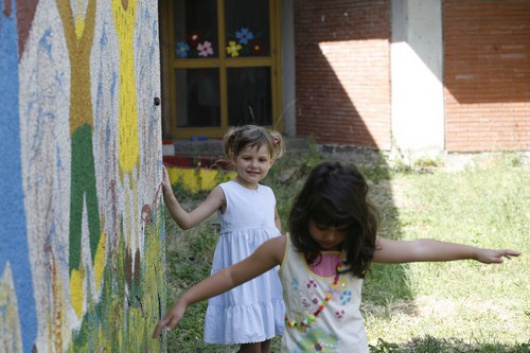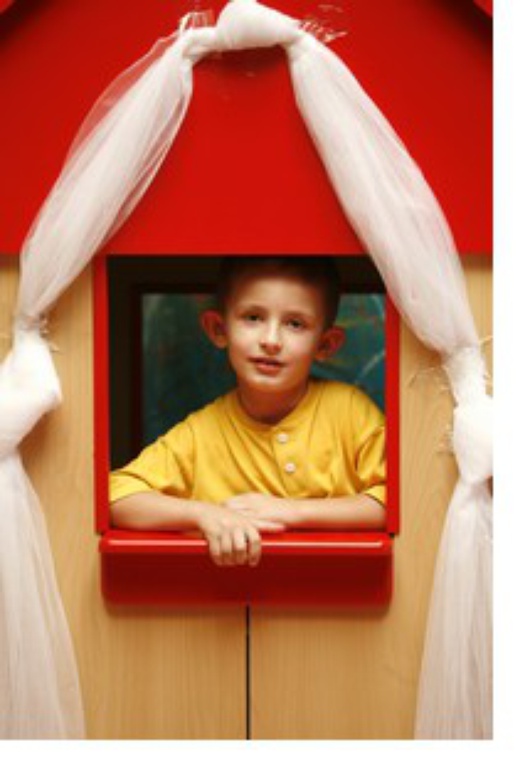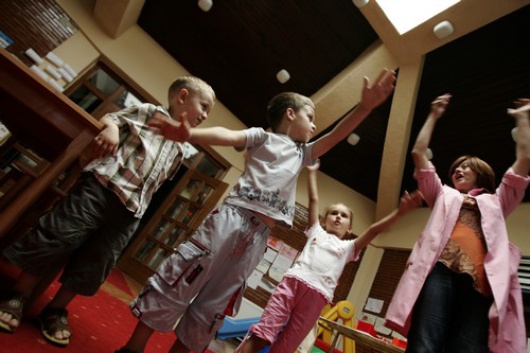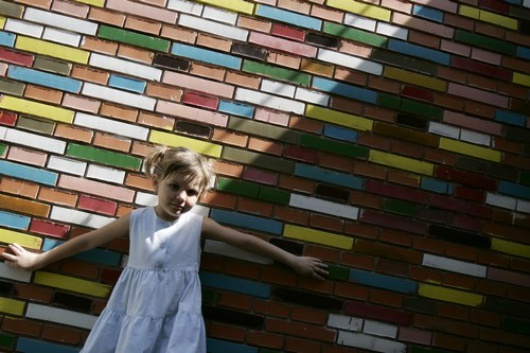Bilingual Kosovar kindergartens
Published on
Translation by:
Nabeelah ShabbirThe 'Mozaik' initiative encourages understanding from a young age between different ethnicities in bilingual nursery schools

Dea and Majla (Photo: ©Hazir Reka)
'My best friends are Amir, Dion and Olti,' says Vranin Garurri, aged 5. Vranin and Dion are Albanian, and Amir and Olti are Bosniacs, as Bosnians in Kosovo are known. Vranin sits on the floor with his friends, like they do together every morning. Their two teachers, Resmije Bujupaj and Asliha Skenderovic, kneel down beside them. They greet the children in their respective native languages and then proceed to tell a story in which various colours set off on an adventure to discover the world. The young ones, aged between three and six, repeat the names of the colours in Bosnian and Albanian. The bookcases are filled with books in both languages. Dea, a young Albanian girl, and her Bosnian friend Majla play together, cleaning the windows of a toy house.
 The 'Mozaik' group formed in April 2007 in the 'Friedenstauben' nursery school in Peja, 85 km west of Pristina. Backed by the humanitarian organisation 'Save the Children' and the Norwegian and US governments, this supra-regional association is a model example of a multicultural education project. As though they are dealing with a bilingual family, two teachers work all day with groups of children with mixed ethnicities. The group, normally composed of between 12 and 20 children, learns not only the language, but also the culture and traditions of their neighbours. The main objective is to create an environment of mutual respect from a young age.
The 'Mozaik' group formed in April 2007 in the 'Friedenstauben' nursery school in Peja, 85 km west of Pristina. Backed by the humanitarian organisation 'Save the Children' and the Norwegian and US governments, this supra-regional association is a model example of a multicultural education project. As though they are dealing with a bilingual family, two teachers work all day with groups of children with mixed ethnicities. The group, normally composed of between 12 and 20 children, learns not only the language, but also the culture and traditions of their neighbours. The main objective is to create an environment of mutual respect from a young age.
Minorities caught between the fronts
More than eight years after the conflict in Kosovo, relations have not drastically improved, and this is also true at 'Mozaik.' 'Normally the parents of these children do not even speak a word to each other,' says Gjejlane Begolli, the Albanian head of the nursery school. 'When I was young, Albanians, Serbs and Bosniacs lived side-by-side and our children learned the Serbo-Croat language of their neighbours.'
 Since the war in Kosovo in 1999, ethnic Kosovar groups have lived completely separately. The border between Serbian enclaves and Albanian residential zones is guarded by Kosovo Force (KFOR) international troops. The success of the ongoing 'Mozaik' project depends mainly on the decision on Kosovo's future status. This slow process is hindering positive development in Kosovo.
Since the war in Kosovo in 1999, ethnic Kosovar groups have lived completely separately. The border between Serbian enclaves and Albanian residential zones is guarded by Kosovo Force (KFOR) international troops. The success of the ongoing 'Mozaik' project depends mainly on the decision on Kosovo's future status. This slow process is hindering positive development in Kosovo.
(Photo: Hazir Reka)
Mozaik
'Mozaik' want to contribute funds to manage the question of ethnic separation. 'The children should live in this mix of cultures and languages, without having the concept of separation by ethnic groups drilled into them,' explains Rudina Ademi from 'Mozaik.' 'So we are starting with the future Kosovo's youngest citizens.'
 After the successful launch of a sister project in the neigbouring republic of Macedonia, the first groups will be created in Kosovo in spring 2008. In the meanwhile Albanian, Bosniac and Turkish children attend bilingual kindergarten. There are also plans to integrate them with Serbian children. 'Mozaik' children are integrated in public nurseries, and the Save the Children organisation funds equipment and materials.
After the successful launch of a sister project in the neigbouring republic of Macedonia, the first groups will be created in Kosovo in spring 2008. In the meanwhile Albanian, Bosniac and Turkish children attend bilingual kindergarten. There are also plans to integrate them with Serbian children. 'Mozaik' children are integrated in public nurseries, and the Save the Children organisation funds equipment and materials.
(Photo: ©Hazir Reka)
Innovating by education
'Mozaik' has a contemporary, child-centered philosophy; a rarety in Kosovo, where multilingual teachers are overworked and forced to work alone with groups of up to thirty children. Moreover, kindergartens are not so typical. Peja, with its 98, 000 habitants, has only one such facility. Many families are out of work. Daily care depending on the neighbourhood can cost from 25 to 50 euros a month, a sum which is quite high if we take into account a monthly salary of 200 euros. But 'Mozaik' costs parents the same amount of money as a normal nursery would.
Sustainability
Save the Children want this project to grow in Kosovo. Almost all the workers in the Prishtina office are natives. A monitor association of experts from the University of Kosovo has been founded. The Kosovar ministry of education, science and technology are also supporting the project.
Meanwhile, the aid organsation have just confirmed a five year programme from 2007 – 2012. In the long term however they plan to pull the project. This would make the local authorities take charge of integrating groups. This represents a big challenge for nurseries already threatened by a lack of places, because the Kosovar education system will see off a number of teachers. And they are in urgent need; the average age of the Kosovar population is 25.
The best education and training for an adolescent generation is a prerequisite for the further development of Kosovo. In the long term it would help also to avoid the emigration of young Kosovan talent. Save the Children plan to extend integrational education to primary school level, so that Amir, Dion, Olti and Vranin can stay friends during school too.
Funded by the 'Erinnerung, Verantwortung und Zukunft' foundation
This article was first published in the German journalist network N-ost
In-text photos: (Hazir Reka)
Translated from Kosovo: Trippelschritte zur Versöhnung



